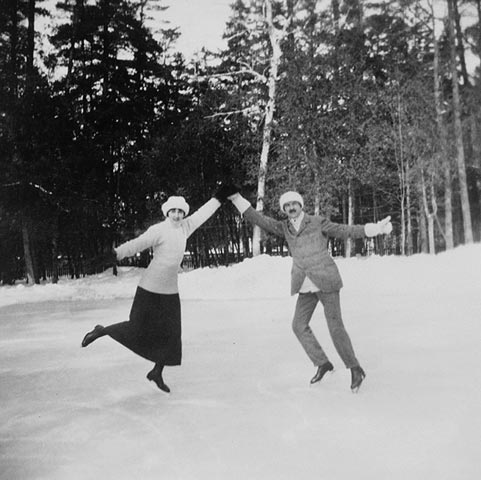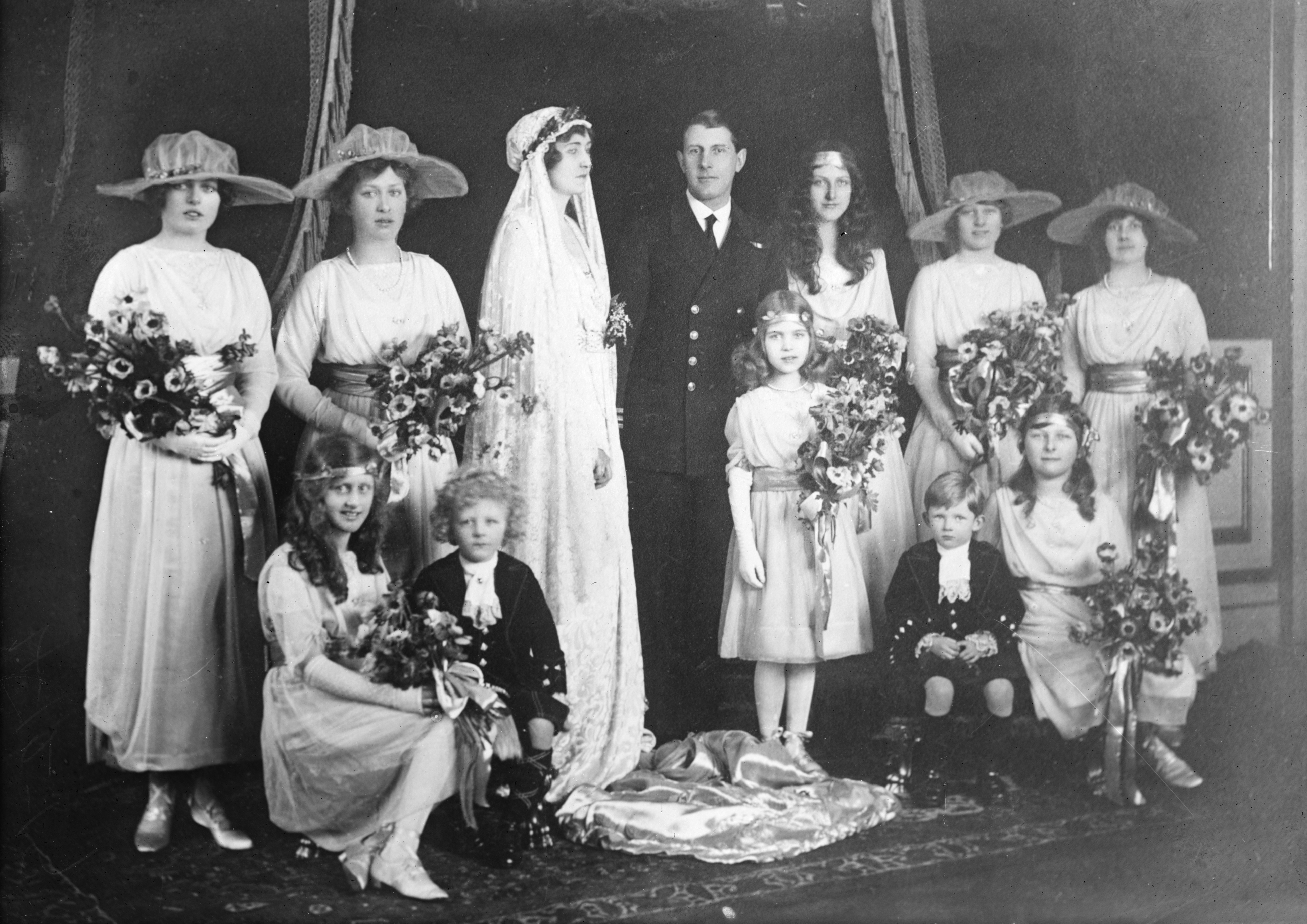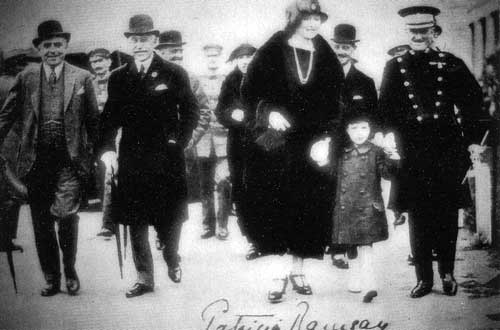1. Early Life and Background
Princess Patricia's early life was marked by her royal lineage, a formal baptism with numerous distinguished godparents, and an upbringing that included extensive travel and participation in significant royal events.
1.1. Birth and Family
Princess Patricia, affectionately known as "Patsy" to her family and friends, was born on March 17, 1886, coinciding with St Patrick's Day, at Buckingham Palace in London. Her father was Prince Arthur, Duke of Connaught and Strathearn, the third son of Queen Victoria and Prince Albert of Saxe-Coburg and Gotha. Her mother was Princess Louise Margaret of Prussia. She had two elder siblings: Prince Arthur of Connaught and Princess Margaret of Connaught, who later became Crown Princess Margareta of Sweden.
1.2. Baptism and Godparents
She was baptized with the full name Victoria Patricia Helena Elizabeth at St Anne's Church in Bagshot on May 1, 1886. Her godparents included several prominent European royals and nobles:
- Queen Victoria (her paternal grandmother)
- The Duke of Saxe-Coburg and Gotha (her paternal granduncle), who was represented by her paternal uncle Prince Christian of Schleswig-Holstein
- The Hereditary Grand Duchess of Oldenburg (her maternal aunt)
- Prince Wilhelm of Prussia (her first cousin), for whom the German Ambassador, Count Hatzfeldt, stood proxy
- Princess Christian of Schleswig-Holstein (her paternal aunt)
- Prince Albert of Prussia (her mother's first cousin once removed), for whom her maternal uncle the Hereditary Grand Duke of Oldenburg stood proxy
She was named Victoria after her paternal grandmother, Queen Victoria; Patricia, after St Patrick, the saint of her birthday; and Helena, in honour of her paternal aunt, Princess Helena of the United Kingdom.
1.3. Childhood and Education
Growing up as a member of the British Royal Family, Princess Patricia's childhood involved frequent travel and participation in royal ceremonies. She was a bridesmaid at the wedding of her cousins, the Duke and Duchess of York (the future King George V and Queen Mary), on July 6, 1893. She also spent two years living in India when her father, the Duke of Connaught, was stationed there with the army. Connaught Place, the central business district of New Delhi, is named in honour of her father.
2. Canada
Princess Patricia developed a deep connection with Canada during her father's tenure as Governor General, becoming a popular figure and maintaining a lifelong association with a distinguished Canadian military regiment.

2.1. Vice-regal Household and Popularity
In 1911, Princess Patricia accompanied her parents to Canada when her father, the Duke of Connaught, was appointed Governor General of Canada. During their time there, she became immensely popular among the Canadian public. Her portrait was featured on the one-dollar note of the Dominion of Canada, issued on March 17, 1917, a testament to her public recognition. While in Canada, her mother, the Duchess of Connaught, passed away in London on March 14, 1917. Princess Patricia inherited 50.00 K GBP from her mother's estate.
2.2. Colonel-in-Chief of Princess Patricia's Canadian Light Infantry
Princess Patricia's most enduring connection to Canada was her appointment as Colonel-in-Chief of Princess Patricia's Canadian Light Infantry (PPCLI) on February 22, 1918, a role she held until her death. This regiment, named in her honour, was unique as it was privately raised by Andrew Hamilton Gault of Montreal at his own expense, making it the last privately raised regiment in the British Empire. Princess Patricia personally designed the regiment's badge and colours for their deployment overseas to France. At her wedding in 1919, the regiment attended and performed their special march. She maintained an active role as Colonel-in-Chief throughout her life, demonstrating a strong commitment to the regiment.
A memorial plaque in St. Bartholomew's Anglican Church in Ottawa is dedicated to her memory, stating: "To the memory of The Lady Patricia Ramsey, VA, CI, CD late Colonel-in-Chief Princess Patricia's Canadian Light Infantry who as H.R.H. the Princess Patricia of Connaught worshipped here while resident at Government House 1911-1916." In 1974, she was succeeded as Colonel-in-Chief by her cousin and goddaughter, Patricia Knatchbull, Countess Mountbatten of Burma, who requested that the regiment refer to her as "Lady Patricia" out of respect for her predecessor.
3. Marriage and Relinquishing Title
Princess Patricia's marriage was a notable event, as she chose to marry outside of royalty, a decision that led to her formal relinquishment of her royal titles and style.

3.1. Marriage to Alexander Ramsay
The question of Princess Patricia's marriage was a significant topic of speculation during the Edwardian era, as she was widely regarded as one of the most beautiful and eligible royal princesses of her generation. She was considered a potential match for various foreign royals, including King Alfonso XIII of Spain, the Prince Royal of Portugal, the future Grand Duke of Mecklenburg-Strelitz, and Grand Duke Michael Alexandrovich of Russia, the younger brother of Tsar Nicholas II.
However, Princess Patricia ultimately chose a commoner as her husband. She married Naval Commander (later Admiral) Alexander Ramsay (May 29, 1881 - October 8, 1972) at Westminster Abbey on February 27, 1919. Ramsay was one of her father's aides-de-camp and the third son of the 13th Earl of Dalhousie.
3.2. Relinquishing Royal Style and Title
On the occasion of her marriage, Princess Patricia of Connaught was granted permission by Royal Warrant to relinquish the style of Royal Highness and the title of Princess of Great Britain and Ireland. By a Royal Warrant issued on February 25, 1919, she was formally granted the style of Lady Victoria Patricia Helena Elizabeth Ramsay, with a special precedence immediately before the Marchionesses of England in the order of precedence.
Lady Patricia and Alexander Ramsay had one child:
- Alexander Arthur Alfonso David Maule Ramsay (December 21, 1919 - December 20, 2000), who married Flora Fraser, 21st Lady Saltoun.
4. Later Life and Artistic Pursuits
Despite relinquishing her royal title, Lady Patricia maintained strong ties to the British Royal Family and developed a notable career as a watercolour artist.

4.1. Continued Royal Connections
Even after relinquishing her royal title, Lady Patricia remained an integral member of the British Royal Family and retained her place in the line of succession to the British throne. She consistently attended all major royal events, including weddings, funerals, and the coronation of King George VI and Queen Elizabeth in 1937 and the coronation of Queen Elizabeth II in 1953. She participated in carriage processions at the funerals of George V in 1936 and King George VI. At coronations, she proceeded in state from Buckingham Palace with other members of the Royal Family, taking part in the procession of princes and princesses of the blood royal, attended by a train-bearer and an officer carrying her coronet. She also attended royal garden parties and participated in state visits, with her attendance regularly recorded in the Court Circular alongside other members of the Royal Family. The coronet Lady Patricia wore at the coronation of Elizabeth II originally belonged to her sister, Princess Margaret of Connaught, and is now preserved at the Swedish Royal Armoury.
4.2. Artistic Career
Lady Patricia was an accomplished artist, specializing in watercolours. Her talent was recognized professionally, and she was made an honorary member of the Royal Institute of Painters in Water Colours in 1959. Much of her artistic work was inspired by her extensive travels in tropical countries. Her style was influenced by the works of Gauguin and Van Gogh, a result of her studies under Archibald Standish Hartrick, who had personal acquaintance with these renowned artists.
5. Death and Burial
Lady Patricia's life concluded in England, where she was laid to rest alongside her husband in the royal burial ground.
5.1. Circumstances of Death
Lady Patricia died at Ribsden Holt, Windlesham, Surrey, on January 12, 1974, just eight weeks before her 88th birthday and fifteen months after the passing of her husband. She was one of only two surviving female granddaughters of Queen Victoria at the time of her death. Probate of her estate was granted in London on April 17, 1974, and it was valued at 917.20 K GBP, which is equivalent to approximately 7.00 M GBP in 2022.
5.2. Burial
Lady Patricia and Admiral Alexander Ramsay are interred together at the Royal Burial Ground, Frogmore, located directly behind the Royal Mausoleum of her grandparents, Queen Victoria and Prince Albert, within Windsor Great Park.
6. Legacy
Princess Patricia's legacy is preserved through numerous places, institutions, and vessels named in her honour, particularly in Canada.
6.1. Named Places and Institutions
Several locations and organizations in Canada bear her name, reflecting her significant connection to the country:
- The Canadian Army infantry regiment, Princess Patricia's Canadian Light Infantry, was named in her honour.
- Patricia Lake in Alberta carries her name.
- The Patricia Bay Highway in Saanich, British Columbia.
- The Regina Patricia Hockey Club, now known as the Regina Pats, was named in her honour. Founded in 1917, it is recognized as the oldest continuously operating major junior hockey franchise in the world, currently playing as part of the Western Hockey League.
- The Patricia Theatre in Powell River, British Columbia, established in 1913, was named in her honour and is the oldest operating theatre in Western Canada.
- Two hamlets in Alberta, located 6.2 mile (10 km) apart, are named Princess and Patricia, both established and named in 1914 in honour of Princess Patricia.
- A Thamesdown bus in Swindon, Wiltshire, England, is also named after her.
6.2. Named Vessels
Maritime vessels have also been named in her honour:
- The TEV Princess Patricia (also known as Princess Patricia II), the second of Canadian Pacific's British Columbia Coast Steamships' two Fairfield Shipyard-built steam turbo-electric passenger ships, was named in 1948 for Princess Patricia of Connaught. She personally launched the ship as Lady Patricia Ramsay at Govan in that year. This vessel became the first ship for Princess Cruises through a winter Mexican Riviera charter from CPL in 1965. It was retired from Alaskan cruising services in 1981 and subsequently served as a floating hotel in Vancouver, British Columbia, for the 1986 World's Fair before being finally scrapped in 1989. Her sister ship was the TEV Princess Marguerite (II).
7. Honours and Military Appointments
Princess Patricia received various honours and held significant honorary military appointments throughout her life.
7.1. Honorary Military Appointments
- February 22, 1918 - January 12, 1974: Colonel-in-chief of Princess Patricia's Canadian Light Infantry.
7.2. Honours and Decorations
- CI: Companion of the Order of the Crown of India, June 19, 1911
- GCStJ: Bailiff Grand Cross of the Venerable Order of Saint John, 1934
- VA: Royal Order of Victoria and Albert
- King George VI Coronation Medal, 1937
- Queen Elizabeth II Coronation Medal, 1953
- CD: Canadian Forces' Decoration with 4 Clasps, 1951
8. Arms and Ancestry
Princess Patricia was granted her own distinct coat of arms upon her marriage, reflecting her royal lineage, and her ancestry traces back through prominent European royal houses.

8.1. Coat of Arms
Upon her marriage in 1919, Lady Patricia was granted arms as a male-line grandchild of a British monarch. Her arms are based on the Royal coat of arms of the United Kingdom but differenced by a specific label. The blazon is as follows:
- Quarterly (by quarters):
- 1st and 4th, Gules three Lions passant guardant in pale Or (England). (The first and fourth quarters display the three lions, representing England.)
- 2nd, quarter is Or a lion rampant within a Double Tressure flory counterflory Gules (Scotland). (The second quarter displays a red lion in a yellow field with a double border coloured red with red fleurs-de-lys, representing Scotland.)
- 3rd, Azure a Harp Or stringed Argent (Ireland). (The third quarter shows a golden harp with silver strings against a blue background, representing Ireland.)
- The whole is differenced by a Label of five points Argent, with the first and fifth points bearing a cross gules, and the other points bearing fleurs-de-lys azure.
8.2. Ancestry
Princess Patricia of Connaught's ancestry can be traced through the following lineage:
- 1. Princess Patricia of Connaught
- 2. Prince Arthur, Duke of Connaught and Strathearn
- 4. Prince Albert of Saxe-Coburg and Gotha
- 8. Ernest I, Duke of Saxe-Coburg and Gotha
- 9. Princess Louise of Saxe-Gotha-Altenburg
- 5. Victoria of the United Kingdom
- 10. Prince Edward, Duke of Kent and Strathearn
- 11. Princess Victoria of Saxe-Coburg-Saalfeld
- 4. Prince Albert of Saxe-Coburg and Gotha
- 3. Princess Louise Margaret of Prussia
- 6. Prince Frederick Charles of Prussia
- 12. Prince Charles of Prussia
- 13. Princess Marie of Saxe-Weimar-Eisenach
- 7. Princess Maria Anna of Anhalt-Dessau
- 14. Leopold IV, Duke of Anhalt
- 15. Princess Frederica of Prussia
- 6. Prince Frederick Charles of Prussia
- 2. Prince Arthur, Duke of Connaught and Strathearn